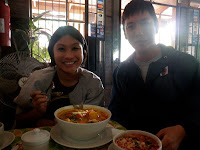
Hey Readers! Hope this posting finds you well. I have some happy news to report, Han and I recently celebrated our 1 year anniversary, and as a present to ourselves, we purchased a Canon EOS Rebel T1i. It takes beautiful food photography shots (a.k.a. food porn) and best of all, we get to feel like real food bloggers, not just the only ones walking around events with our dinky point-and-shoot.
Anyways, we decided to break out the new camera with a trip out to Zoot at their new(-
ish) location way out west on Bee Caves near the lake. We caught a Living Social deal a few months back. $27 gets you your choice of the Chef's Tasting Menu or the Farmer's (vegetarian) Tasting Menu. We opted to go for one of each so that we could try a little bit of everything. Let me tell you guys, as good as the Chef's Tasting Menu was, I think any ferocious meat eater would also be hard pressed to say that the Farmer's Menu didn't also stand up pound-for-pound.
The first course was a Boudin sausage salad for the Chef's and Melon Salad with goat cheese for the Farmer's. The sausage salad was pretty good as you'd imagine, but the melon salad was definitely the more interesting dish. The cantaloupe was sliced thin like fat linguine noodles, and topped with cubes of watermelon, almonds, goat cheese, cayenne pepper, and a soy ginger dressing.

The next appetizer was a ham and fig salad for the chef's menu, and butternut squash soup for the farmer's menu. One of my favorite parts about going to nice r
estaurants is discovering really great food pairings that I never would have guessed. In this case, in the salad, it was figs and goat cheese. You've probably heard me say before that Han hates anything coming from an animal that goes "baa" but even she liked this one.
The next course was a soy/miso salmon and a mushroom risotto (left). Both dishes were

excellent. Consequently, these two dishes were not only our two favorites, but also the two that turned out the best in pictures, so they are the ones shown.
The final courses (before dessert) was a grilled NY strip steak for the chef's and these curried lentils and fried potato things for the farmer's. Now I meant what I said earlier about the veggie tasting menu being a close call even for meat eaters, and this was no different. For many meat eaters, steak is like the holy grail. I haven't been eating a ton of meat as of late, but I really thought this battle would be no contest. In the end, it really was tough to decided. I really think one of the best parts of being in a relationship (especially with someone else who loves food as much as I do) is that you don't HAVE to decide between two dishes.
The final course was the flourless chocolate cake. I'm not a big wine guy myself. I enjoy drinking it, but it's hard for me in most cases to say that a specific pairing really made that much of a difference in a dish. In this case however, the dessert wine that was paired with the cake made a huge difference. The tartness and bubbliness of the sparkling dessert wine made the cake taste like an entirely different dessert.
Well I don't think anyone really needed me to say something like "Zoot is indeed a great restaurant and you should definitely check it out." I'm just really glad we got the opportunity to celebrate in style. Til next time folks!




















.jpg)
.jpg)


.jpg)

.jpg)
.jpg)




